
Virtual task modelling is helping experts to factor in the limitations of the human body in order to reduce the chance of repetitive strain injuries, while also improving production efficiencies across manufacturing plants
OEMs and suppliers around the world continue to develop increasingly more sophisticated vehicles which feature improved performance, economy and a longer working life, but the same cannot be said of the manufacturing workforce delivering these vehicles, which remain static due to the inherent limitations of the human body. This means that taking into account the human element in the build process of these vehicles is an increasingly important part of production design. From stamping to final assembly, designers, packaging, production and manufacturing engineers must consider these human factors early in the product lifecycle.
More than 100 years after Henry Ford pioneered the moving assembly line, the carmaker is still refining its founder’s industry-changing innovation. To address issues such as an ageing workforce and the physical impact of long-term work on the production line, Ford convened a team of occupational physicians, production specialists, labour groups and representatives for disabled employees in order to investigate improved ergonomics, safety and productivity.
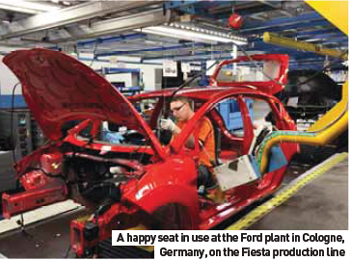 This led to the creation of the ‘happy seat’, essentially a swivel chair attached to a rod-shaped suspension arm. Where as the worker would have had to repeatedly bend over in order to install items such as a pedal box, this equipment allows line workers to sit comfortably while performing their given task on the assembly line, the seat smoothly gliding into position within the carbody as it travels along the line.
This led to the creation of the ‘happy seat’, essentially a swivel chair attached to a rod-shaped suspension arm. Where as the worker would have had to repeatedly bend over in order to install items such as a pedal box, this equipment allows line workers to sit comfortably while performing their given task on the assembly line, the seat smoothly gliding into position within the carbody as it travels along the line.
The first happy seat was installed in the roof antennae wiring workstation on the assembly line at Ford’s Genk plant in Belgium in 1998. Ford Cologne’s example of the same followed in 2002. Today, happy seats are also in use at Ford plants in Valencia, Spain, and Saarlouis, Germany.
“It’s called the happy seat for a good reason – it makes a tough job easier for workers in our plants,” says Eilis Carey, Senior Ergonomist for Ford of Europe. “Operations which previously required awkward postures to be maintained for prolonged periods can now be performed in a seated position with adequate lumbar support.”
The happy seat allows employees with more experience to stay integrated in existing work groups while health and productivity levels are retained. “The ergonomics of the workstation are improved and operator discomfort and fatigue are reduced, leading to reduced injuries and illnesses, fewer lost work days and improved quality of the operations,” says Carey.
Martin Chapman, Operations Manager at Ford Cologne, adds: “Employees just push themselves back and forth and the chair swings in and out of the cabin – very simply and not requiring much physical effort. And their back feels fine, allowing employees to remain in employment longer to the benefit of Ford.”
Given the ageing European population and increases in retirement ages in some countries, Ford’s happy seat has become especially relevant to the 21st Century workplace. Further measures used by Ford to assist production line workers include movable platforms that raise vehicle chassis to variable heights, reducing the need for employees to excessively stretch and bend to reach work areas.
The virtues of the virtual workstation
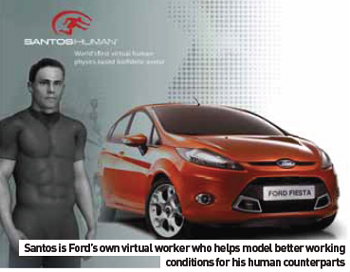 Ford also uses virtual software programs to design ergonomic production processes. Santos, a computerised avatar - or character – is used to perform actions in the virtual world to help the carmaker improve quality, safety and ergonomics for its assembly line employees.
Ford also uses virtual software programs to design ergonomic production processes. Santos, a computerised avatar - or character – is used to perform actions in the virtual world to help the carmaker improve quality, safety and ergonomics for its assembly line employees.
While OEMs such as Ford have developed their own software for modelling virtual workplaces, there are many solutions available from providers including Delmia.
The company’s Virtual Ergonomics suite of digital human modelling tools are fully integrated into its Digital Process for Manufacture (DPM) solutions package. This provides OEMs and Tier suppliers with a comprehensive array of human simulation and ergonomics tools specifically designed for understanding and optimizing the relationship between humans and the products they manufacture, install, operate, and maintain under the banner Total Design Lifecycle Human Modelling.
Creating and developing products based on the capabilities and limitations of people is not a new concept. Engineering departments and ergonomists have proven that every stage of a product’s lifecycle has a common component – people. Digital human modelling technology can assist a designer in determining the performance of people in the context of a workplace, or their interaction with a product throughout its entire lifecycle, from conceptual planning through to final decommissioning, before the product exists.
The company’s Human Builder solution provides a tool for the creation and manipulation of accurate standard digital humans for initial worker/product interaction analysis.
Human Builder offers a user-friendly interface and ensures that first-level ‘Human Factors’ studies can be undertaken by non-Human Factors specialists. Pull-down menus are used to create standard male and female manikins, where the manikin structure consists of 99 independent links, segments and ellipses. In addition, the manikin possesses fully-articulated hand, spine, shoulder, and neck models to accurately reproduce natural movement, which includes seven default inverse kinematics for manikin motion.
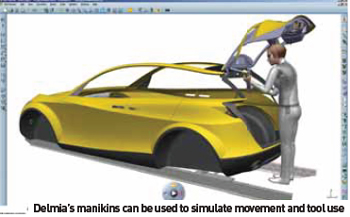 Delmia’s Human Task Simulation is used to create and validate activities for ‘workers’ using the DPM planning and simulation infrastructure. Workers perform these activities within the environment, perhaps walking to a specific location, up and down stairs or ladders and from one target posture to another. In addition, the ‘humans’ can automatically grasp and pick and place parts within the work area.
Delmia’s Human Task Simulation is used to create and validate activities for ‘workers’ using the DPM planning and simulation infrastructure. Workers perform these activities within the environment, perhaps walking to a specific location, up and down stairs or ladders and from one target posture to another. In addition, the ‘humans’ can automatically grasp and pick and place parts within the work area.
Users of the software can further establish part relations to constrain specific segments of the worker to parts or tools within its environment. Position constraints are also stored from selected segments to individual 3D objects in the environment or other software packages. Those constraints are subsequently solved to update the posture the next time the activity is modified. The Virtual Ergonomics suite can be combined with the company’s DPM Assembly application to analyze the relationship between workers and other entities within the simulation, allowing the user to test and optimize multiple alternatives for the work humans in a specific manufacturing, maintainability and assembly environment.
Human Activity Analysis allows the user to maximize human comfort, safety, and performance through a wide range of advanced ergonomics analysis tools and standards that comprehensively evaluate all elements of a worker’s interactions within a work cell. Delmia’s human activity tools specifically analyze how a worker will interact with objects in the virtual environment, allowing users to predict human performance to ensure conformance to factory standards and maximizing actual performance. Delmia Human
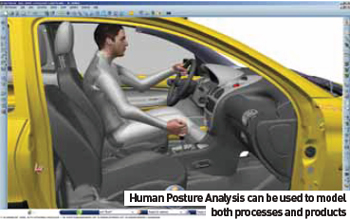 Human Posture Analysis permits quantitative and qualitative analysis of all aspects of a worker’s posture. Whole body and localized postures can be examined, scored, and iterated to determine worker comfort, safety, strength, and performance when interacting with a product in accordance with published comfort databases.
Human Posture Analysis permits quantitative and qualitative analysis of all aspects of a worker’s posture. Whole body and localized postures can be examined, scored, and iterated to determine worker comfort, safety, strength, and performance when interacting with a product in accordance with published comfort databases.
User-friendly dialogue panels provide postural information for all segments of the manikin and colour coding techniques ensure that problem areas can be quickly identified to optimize posture.
A vital element of creating a comfortable and efficient production environment is timely and rapid part access and replenishment for lineside stock. While the human body may be protected from uncomfortable and potentially damaging operations, worker dissatisfaction and loss of motivation may be caused by mental factors such as frustration in being unable to maintain a steady and productive work flow due to lineside shortages.
To combat glitches in supply and involve workers by putting them in control of lineside delivery requests, Getrag Ford Transmissions, one of the largest manufacturers of automotive transmissions in the world, has deployed WhereNet’s new Material Flow-Replenishment system at its two million square foot assembly plant in Cologne, Germany. This system helps to automate parts replenishment as part of the company’s lean manufacturing initiative.
Getrag Ford Transmissions is one of the first automotive industry manufacturers to use WhereNet’s Material Flow- Replenishment system, which combines business intelligence with real-time location and consumption-based demand data. Implemented in less than 90 days, the WhereNet system plays a critical role in managing a complex manufacturing environment; Getrag Ford Transmissions in Cologne produces six different transmission varieties for global brands including Ford, Mazda and Volvo. In total, the plant manufactures more than one million units per year, which are then shipped to manufacturers located in Argentina, China, Europe, Japan, South Africa, Taiwan, the Philippines, and the United States.
Tracked, prioritized - and flexible
The flexible parts replenishment solution tracks the exact time of every part request, prioritizes the requests, and sends instructions to material handling drivers whose vehicles are equipped with vehicle-mounted Wi-Fi terminals which alert as to where to pick up and deliver the parts. The system also alerts the manufacturer and suppliers when parts are needed on the assembly line, resulting in a synchronous material flow across the supply chain, reduced inventory, and increasing productivity.
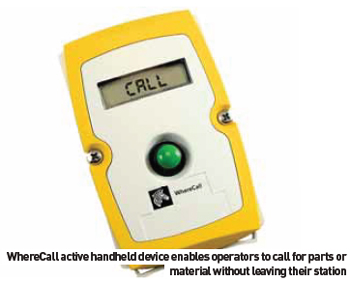 Running in German and offered in 15 other languages, the WhereNet system at Getrag Ford Transmissions consists of the Material Flow-Replenishment application, a wireless messaging infrastructure of 220 active RFID WhereCall buttons (each of which is uniquely associated with a part number on the assembly line), a network of 12 wireless WhereLAN location sensors and five Akerstroms (recently acquired by LXE, an EMS Technologies company) mobile computers, which are mounted on the forklifts.
Running in German and offered in 15 other languages, the WhereNet system at Getrag Ford Transmissions consists of the Material Flow-Replenishment application, a wireless messaging infrastructure of 220 active RFID WhereCall buttons (each of which is uniquely associated with a part number on the assembly line), a network of 12 wireless WhereLAN location sensors and five Akerstroms (recently acquired by LXE, an EMS Technologies company) mobile computers, which are mounted on the forklifts.
“The WhereNet material flow system moves us a long way toward our ultimate goal of a completely forklift-less production operation, as we are now operating leaner than ever before,” says Ralf Vierkotten, Supervisor for Logistics and Material Handling at Getrag Ford Transmissions.
“Production line employees no longer need to leave their workstation to help search for parts or to help material control determine the correct part; all they have to do is push a WhereCall active RFID button and the system notifies all the required parties, from the line side to the forklift driver to the internal warehouse. This ‘intelligent’ automated system supports our lean manufacturing processes as we benefit from real-time inventory consumption and can execute replenishment orders just in time.”
Based on the success of this initial implementation, Getrag Ford Transmissions is planning to rollout a second phase of the project at its Cologne factory, and implement the system at other facilities.
WhereNet’s Material Flow-Replenishment system controls the routing of material not only throughout the assembly plant, but also across the supply chain. The system’s supplier portal allows suppliers to receive real-time demand signals and ship parts from within the portal based on that demand. The system manages the synchronous flow of parts from the supplier to the dock door at the plant, from the plant’s warehouse to the staging lane, and ultimately to the appropriate assembly line operator.
Johnson Controls (JCI) speeds its aftermarket car parts to customers including Mopar, Toyota and Daimler in 48 hours or less. Recently, a new automated inventory management and shipping system installed at JCI has helped to improve service. For customers like Mopar, JCI keeps several years of inventory on hand in order to facilitate a quick turnaround for dealers requiring specific parts. Plant Manager Tom Johnson oversees JCI’s Winchester, KY, aftermarket service centre. The centre stores replacement automotive parts, including seat assemblies and other large automobile interior components. “We needed a system to ensure proper picking of on-hand inventory to meet our daily customer orders,” he says.
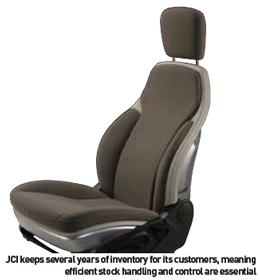 Currently JCI ships service parts to nearly 8,500 automotive dealers in North America, while it is expanding its automated system to handle parts for other automotive manufacturers. Johnson reports the new inventory management and shipping system has significantly improved Mopar’s fill rate. “Bringing on Mopar meant a ten-fold increase in the amount of storage space required,” Johnson reports.
Currently JCI ships service parts to nearly 8,500 automotive dealers in North America, while it is expanding its automated system to handle parts for other automotive manufacturers. Johnson reports the new inventory management and shipping system has significantly improved Mopar’s fill rate. “Bringing on Mopar meant a ten-fold increase in the amount of storage space required,” Johnson reports.
JCI began by evaluating a number of warehouse management systems (WMS) that were capable of handling its needs. Selecting RT Systems to deliver the system, JCI worked with the supplier to develop the SMART system, which is based on the RT Locator WMS product. System flow incoming orders are received from Mopar’s parts division via electronic data interchange (EDI) and shipping orders are sent via the JCI system to SMART on a regular basis. Most incoming material is bar coded; if bar code labels are not present, JCI produces its own. The system uses spread-spectrum RF terminals with tethered laser scanners to identify incoming products.
After product is received, the system directs the operator to enter the part number and quantity, store the product in an empty storage area, and scan a location bar code to update the system on the product’s location. Shipping orders are sent to the SMART server, at an average of 350 orders per day, typically consisting of one part per order.
The RT Locator SMART system determines whether the order is for a finished goods item or if components should be picked for assembly. Finished goods are delivered directly to a packing station. For assembly items, components are picked in bar coded totes and the totes containing the component parts are sent to an assembly area. Assembled components are placed into the same component picking tote and sent to the packing station.
At the packing station, the shipper scans a tote, while the system displays the tote contents. The packer is directed to place the parts into the default carton size, unless the goods are pre-packaged. Then, one of 10 UPS service codes is chosen or an ‘other’ option is selected for alternative carriers. The RT Locator SMART system then prints out a bar coded shipping label. The shipping information from the UPS system is then transferred to SMART in order to update the JCI system.
The RT Locator SMART system has improved order accuracy and enabled JCI to achieve a 95% fill rate for its customers. Because JCI can conduct cycle counts throughout the 140,000 sq. ft. facility, inventory accuracy has reached almost 100%. Order turnaround time has also been reduced.
“Originally, our goal was to fulfill dealer orders within 48 hours,” Johnson says. “Now, the system allows us to pull orders for same-day shipping, provided the needed materials are in stock.” Improved response time in the warehouse allows JCI to use alternate shipping methods, which can deliver substantial customer savings. ”We can use costeffective UPS ground delivery, as opposed to second-day air or next-day air, and still get the product to the end user within 48 hours from receipt of the order,” Johnson says. Since implementation, the system has saved Mopar $114,000 in shipping costs.


































